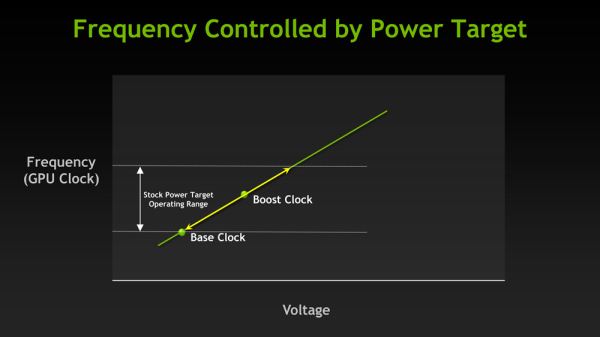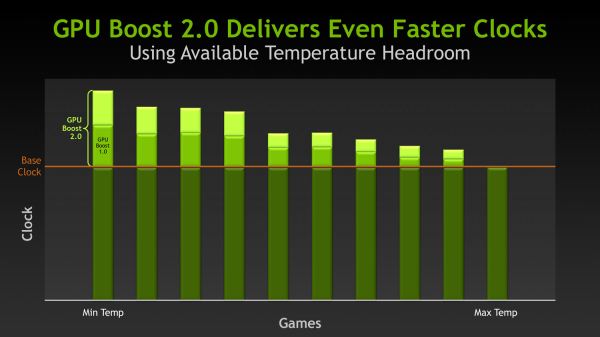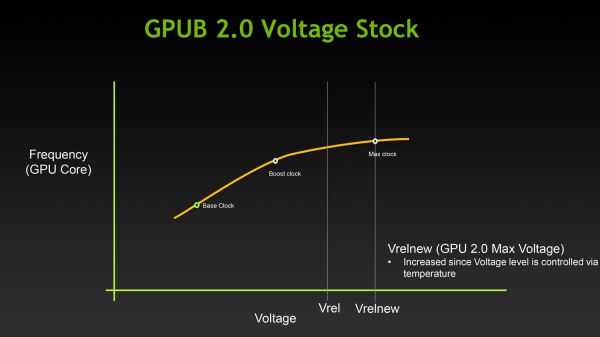NVIDIA's GeForce GTX Titan, Part 1: Titan For Gaming, Titan For Compute
by Ryan Smith on February 19, 2013 9:01 AM ESTGPU Boost 2.0: Temperature Based Boosting
With the Kepler family NVIDIA introduced their GPU Boost functionality. Present on the desktop GTX 660 and above, boost allows NVIDIA’s GPUs to turbo up to frequencies above their base clock so long as there is sufficient power headroom to operate at those higher clockspeeds and the voltages they require. Boost, like turbo and other implementations, is essentially a form of performance min-maxing, allowing GPUs to offer higher clockspeeds for lighter workloads while still staying within their absolute TDP limits.
With the first iteration of GPU Boost, GPU Boost was based almost entirely around power considerations. With the exception of an automatic 1 bin (13MHz) step down in high temperatures to compensate for increased power consumption, whether GPU Boost could boost and by how much depended on how much power headroom was available. So long as there was headroom, GPU Boost could boost up to its maximum boost bin and voltage.
For Titan, GPU Boost has undergone a small but important change that has significant ramifications to how GPU Boost works, and how much it boosts by. And that change is that with GPU Boost 2, NVIDIA has essentially moved on from a power-based boost system to a temperature-based boost system. Or perhaps more precisely, a system that is predominantly temperature based but is also capable of taking power into account.
When it came to GPU Boost 1, its greatest weakness as explained by NVIDIA is that it essentially made conservative assumptions about temperatures and the interplay between high temperatures and high voltages in order keep from seriously impacting silicon longevity. The end result being that NVIDIA was picking boost bin voltages based on the worst case temperatures, which meant those conservative assumptions about temperatures translated into conservative voltages.
So how does a temperature based system fix this? By better mapping the relationship between voltage, temperature, and reliability, NVIDIA can allow for higher voltages – and hence higher clockspeeds – by being able to finely control which boost bin is hit based on temperature. As temperatures start ramping up, NVIDIA can ramp down the boost bins until an equilibrium is reached.
Of course total power consumption is still a technical concern here, though much less so. Technically NVIDIA is watching both the temperature and the power consumption and clamping down when either is hit. But since GPU Boost 2 does away with the concept of separate power targets – sticking solely with the TDP instead – in the design of Titan there’s quite a bit more room for boosting thanks to the fact that it can keep on boosting right up until the point it hits the 250W TDP limit. Our Titan sample can boost its clockspeed by up to 19% (837MHz to 992MHz), whereas our GTX 680 sample could only boost by 10% (1006MHz to 1110MHz).
Ultimately however whether GPU Boost 2 is power sensitive is actually a control panel setting, meaning that power sensitivity can be disabled. By default GPU Boost will monitor both temperature and power, but 3rd party overclocking utilities such as EVGA Precision X can prioritize temperature over power, at which point GPU Boost 2 can actually ignore TDP to a certain extent to focus on power. So if nothing else there’s quite a bit more flexibility with GPU Boost 2 than there was with GPU Boost 1.
Unfortunately because GPU Boost 2 is only implemented in Titan it’s hard to evaluate just how much “better” this is in any quantities sense. We will be able to present specific Titan numbers on Thursday, but other than saying that our Titan maxed out at 992MHz at its highest boost bin of 1.162v, we can’t directly compare it to how the GTX 680 handled things.













157 Comments
View All Comments
vacaloca - Wednesday, February 20, 2013 - link
I'm assuming TCC driver would not work stock... if it's anything like the GTX 480 that could be BIOS/softstraps modded to work as Tesla C2050, it might be possible to get the HyperQ MPI, GPU Direct RDMA, and TCC support by doing the same except with a K20 or K20X BIOS. This would probably mean that the display outputs on the Titan card would be bricked. That being said, it's not entirely trivial... see below for details:https://devtalk.nvidia.com/default/topic/489965/cu...
tjhb - Thursday, February 21, 2013 - link
That's an amazing thread. How civilised, that NVIDIA didn't nuke it.I'm only interested in what is directly supported by NVIDIA, so I'll use the new card for both display and compute.
Thanks!
Arakageeta - Wednesday, February 20, 2013 - link
Thanks! I wasn't able to find this information anywhere else.Looks like the cheapest current-gen dual-copy engine GPU out there is still the Quadro K5000 (GK104-based) for $1800. For a dual-copy engine GK110, you need to shell out $3500. That's a steep price for a small research grant!
Shadowmaster625 - Tuesday, February 19, 2013 - link
For the same price as this thing, AMD could make a 7970 with a FX8350 all on the same die. Throw in 6GB of GDDR5 and 288GB/sec memory bandwidth and a custom ITX board and you'd have a generic PC gaming "console". Why dont they just release their own "AMDStation"?Ananke - Tuesday, February 19, 2013 - link
They will. It's called SONY Play Station 4 :)da_cm - Tuesday, February 19, 2013 - link
"Altogether GK110 is a massive chip, coming in at 7.1 billion transistors, occupying 551m2 on TSMC’s 28nm process."Damn, gonna need a bigger house to fit that one in :D.
Hrel - Tuesday, February 19, 2013 - link
I've still never even seen a monitor that has a display port. Can someone please make a card with 4 HDMI port, PLEASE!Kevin G - Tuesday, February 19, 2013 - link
Odd, I have two different monitors has home and a third at work that'll accept a DP input.They do carry a bit of a premium over those with just DVI though.
jackstar7 - Tuesday, February 19, 2013 - link
Well, I've got Samsung monitors that can only do 60Hz via HDMI, but 120Hz via DP. So I'd much rather see more DisplayPort adoption.Hrel - Thursday, February 21, 2013 - link
I only ever buy monitors with HDMI on them. I think anything beyond 1080p is silly. (lack of native content) Both support WAY more than 1080p, so I see no reason to spend more. I'm sure if I bought a 2560x1440 monitor it'd have DP. But I won't ever do that. I'd buy a 19200x10800 monitor though; one day.